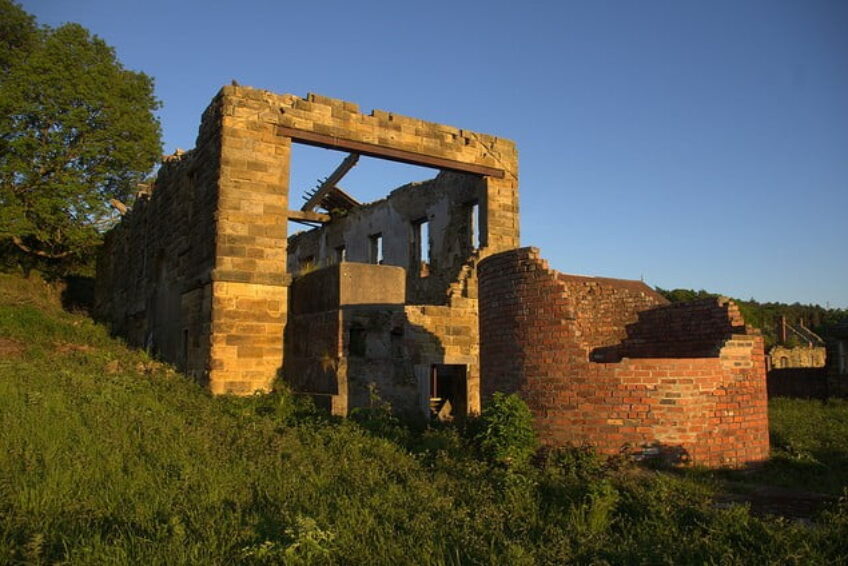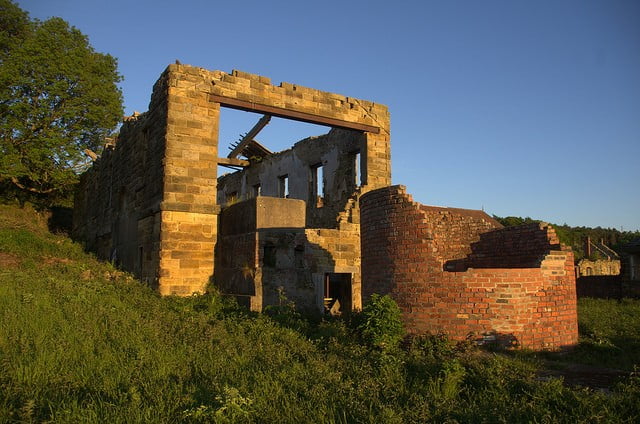
Skelton Park is the most complete set of ironstone mining buildings left in Cleveland.
Skelton Park Pit was operated by the Bell Brothers between 1872 and 1923, then Dorman Long until 1938. They only stopped when they ran out of ironstone down there!
The first shaft was sunk to exploit a 10 ft thick seam, at a depth of circa 400 feet and a second shaft sunk later on to exploit another iron-rich seam.
The Bell brothers were Isaac Lowthian, Thomas and John Bell and they mined here to supply their ironworks at Port Clarence on the north bank of the River Tees. The mineral rights and land was leased from Mr Wharton of Skelton Castle. Park Pit worked the Cleveland Main Seam of ironstone which had an iron content of about 32%; making it about the highest concentration of iron found within Cleveland ironstone. Southwards, this seam became closer to the surface where it was worked by Bell Brothers via the associated Skelton Shaft and Spa Mines (the latter mine sold in 1872).
The Cleveland Main Seam was first exploited elsewhere at Eston, by Bolckow and Vaughan from the 1850s. This prompted the rapid development of the Teeside iron industry, making Middlesbrough the centre of the world’s iron market in the late C19.
The Bell Brothers company was a leading player in the Cleveland iron industry, with Park Pit being their most significant mine.
The buildings were used as a farm until 1986, then left derelict and now increasingly becoming vandalised and collapsing. It has been mentioned by people that explored the site 20 years ago, that rapid deterioration has since taken place. The buildings were listed circa 1985, but that hasn’t prevented theft of materials or neglect by the landowners.
The Inspector at English Heritage described this site as having national importance.
The remains include; the engine house, the base of the chimney, manager’s house, blacksmiths shops, a magazine, boiler, store and preparation building for horse feed for pit ponies (used for underground haulage and horse-gin) and horse-gin earthworks and more!
This is a complex site that provides evidence of several phases of mining styles, including the use of pit and surface ponies, mechanisation and electrification in the 1900s.
Quite a site and as a complete array, very precious indeed!

Skelton Park is the most complete set of ironstone mining buildings left in Cleveland.
Skelton Park Pit was operated by the Bell Brothers between 1872 and 1923, then Dorman Long until 1938. They only stopped when they ran out of ironstone down there!
The first shaft was sunk to exploit a 10 ft thick seam, at a depth of circa 400 feet and a second shaft sunk later on to exploit another iron-rich seam.
The Bell brothers were Isaac Lowthian, Thomas and John Bell and they mined here to supply their ironworks at Port Clarence on the north bank of the River Tees. The mineral rights and land was leased from Mr Wharton of Skelton Castle. Park Pit worked the Cleveland Main Seam of ironstone which had an iron content of about 32%; making it about the highest concentration of iron found within Cleveland ironstone. Southwards, this seam became closer to the surface where it was worked by Bell Brothers via the associated Skelton Shaft and Spa Mines (the latter mine sold in 1872).
The Cleveland Main Seam was first exploited elsewhere at Eston, by Bolckow and Vaughan from the 1850s. This prompted the rapid development of the Teeside iron industry, making Middlesbrough the centre of the world’s iron market in the late C19.
The Bell Brothers company was a leading player in the Cleveland iron industry, with Park Pit being their most significant mine.
The buildings were used as a farm until 1986, then left derelict and now increasingly becoming vandalised and collapsing. It has been mentioned by people that explored the site 20 years ago, that rapid deterioration has since taken place. The buildings were listed circa 1985, but that hasn’t prevented theft of materials or neglect by the landowners.
The Inspector at English Heritage described this site as having national importance.
The remains include; the engine house, the base of the chimney, manager’s house, blacksmiths shops, a magazine, boiler, store and preparation building for horse feed for pit ponies (used for underground haulage and horse-gin) and horse-gin earthworks and more!
This is a complex site that provides evidence of several phases of mining styles, including the use of pit and surface ponies, mechanisation and electrification in the 1900s.
Quite a site and as a complete array, very precious indeed!

